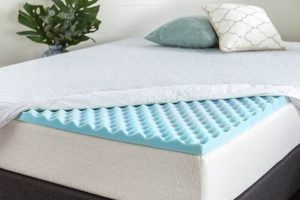This bedding accessory is designed to be placed atop a king-sized mattress, incorporating viscoelastic foam as its primary component. Viscoelastic foam, often referred to as “memory” foam, conforms to the body’s shape in response to pressure, providing targeted support and pressure relief. Its dimensions are specifically tailored to fit the standard king mattress size, offering a consistent surface area for enhanced comfort across the entire bed.
The addition of such a component to a sleeping surface can significantly improve the sleeping experience by enhancing support, potentially alleviating pressure points, and customizing the firmness level of an existing mattress. Historically, the integration of these foam layers into bedding reflects an evolution in sleep technology aimed at maximizing comfort and addressing individual sleep preferences. Its development is linked to advancements in material science and a growing understanding of ergonomic principles related to sleep posture.
The subsequent sections will explore the various characteristics, benefits, materials, and considerations involved in selecting the appropriate model for individual needs. These considerations include density, thickness, certifications, and their overall impact on sleep quality. This will allow for a more informed decision-making process when considering such a purchase.
Essential Considerations for Selecting a Viscoelastic Foam Overlay for a King Mattress
The following points provide guidance in selecting a bedding component comprised of viscoelastic foam designed to fit a king-sized mattress, optimizing sleep comfort and mattress longevity.
Tip 1: Density Assessment. Prioritize density over thickness; higher density indicates greater support and durability. A density of 4-5 pounds per cubic foot is generally considered optimal for pressure relief and longevity. Lower density options may degrade more quickly.
Tip 2: Thickness Evaluation. Determine the appropriate thickness based on the existing mattress’s firmness and desired level of comfort modification. A 2-3 inch thickness often provides a balanced improvement in comfort without excessively altering the mattress’s feel. Individuals requiring significant pressure relief might consider thicker options.
Tip 3: Material Certification. Verify certifications such as CertiPUR-US, which ensures the absence of harmful chemicals and low VOC emissions. These certifications indicate compliance with safety standards and contribute to a healthier sleep environment.
Tip 4: Temperature Regulation. Consider options incorporating cooling technologies such as gel infusions or open-cell structures to mitigate heat retention. These features enhance breathability and promote a more comfortable sleep temperature, particularly for individuals prone to overheating.
Tip 5: Firmness Selection. Align firmness with individual sleep preferences and pressure point needs. Softer options are suitable for side sleepers, while firmer options provide better support for back and stomach sleepers. Evaluate the existing mattress’s firmness to select an appropriate complement.
Tip 6: Cover Material. Examine the cover material for breathability and hypoallergenic properties. Natural fibers such as bamboo or cotton promote airflow and minimize the risk of allergic reactions. A removable and washable cover simplifies maintenance and hygiene.
Tip 7: Edge Support. Assess the edge support, particularly if the sleeping surface is frequently utilized near the edges. Reinforced edges prevent sagging and maintain consistent support across the entire surface.
Adhering to these considerations ensures selection of a viscoelastic foam bedding enhancement that addresses individual needs, promotes optimal sleep quality, and extends the lifespan of the underlying mattress.
The subsequent discussion will address specific scenarios and advanced factors impacting the overall performance and suitability of these bedding components.
1. Density
Density, in the context of viscoelastic foam bedding components designed for king-sized mattresses, is a critical determinant of performance, longevity, and overall value. It refers to the mass of the foam per unit volume, typically measured in pounds per cubic foot (lbs/ft). Higher density materials generally exhibit enhanced durability and support characteristics.
- Support and Pressure Relief
Higher density foam provides greater resistance to compression, offering enhanced support for the body. This translates to better spinal alignment and reduced pressure on sensitive areas such as the hips, shoulders, and back. Lower density foam, conversely, may compress excessively, leading to inadequate support and increased pressure points.
- Durability and Lifespan
Density is directly correlated with the lifespan of the foam. Higher density foams withstand repeated compression and deformation more effectively than lower density counterparts. This resistance to wear and tear translates into a longer lifespan for the foam and a sustained level of performance over time. Cheaper, less dense options degrade more rapidly, requiring more frequent replacement.
- Conformity and Responsiveness
While high density provides support, the responsiveness of the foam is also influenced. The ability of the material to conform to the body’s contours and quickly return to its original shape is crucial for comfort. An optimal density balances support with the necessary degree of conformity to ensure adequate pressure relief and minimize motion transfer.
- Temperature Sensitivity
The composition and density of the foam affect its thermal properties. Higher density materials tend to retain more heat, which can be a concern for individuals who sleep hot. Therefore, density must be considered in conjunction with cooling technologies, such as gel infusions or open-cell structures, to mitigate heat retention and promote a comfortable sleep environment.
In summary, density is a primary consideration when evaluating a viscoelastic foam enhancement for a king-sized mattress. Balancing support, durability, conformity, and thermal properties requires careful assessment of the foam’s density in relation to individual sleep preferences and needs. Selecting an appropriate density ensures a lasting improvement in sleep quality and overall mattress performance.
2. Thickness
The thickness of a viscoelastic foam overlay designed for a king-sized mattress directly impacts the degree of comfort modification and support provided. The correlation between the overlay’s thickness and the existing mattress determines the extent to which the sleeping surface is altered. Thicker options generally offer more pronounced pressure relief and contouring, while th
inner options primarily serve to subtly adjust the firmness level. The influence of thickness on the overall sleep experience necessitates careful consideration during the selection process. For instance, an individual with an overly firm mattress might choose a thicker overlay to introduce a softer, more conforming surface, effectively mitigating pressure points. Conversely, someone seeking only a slight enhancement in comfort may opt for a thinner profile.
The selection of an appropriate thickness also involves practical considerations related to bed height and ease of movement. A particularly thick overlay can significantly increase the overall height of the bed, potentially posing challenges for individuals with mobility limitations or those accustomed to a lower sleeping surface. Moreover, extremely thick options may reduce the stability of the mattress and make it more difficult to change bedding. Conversely, an inadequate thickness may fail to deliver the desired level of comfort and support, negating the intended benefits of the added layer. The relationship between thickness and body weight should also be factored in; heavier individuals may require greater thickness to ensure adequate support and prevent bottoming out.
In conclusion, thickness serves as a primary determinant of the overall performance and suitability of a viscoelastic foam bedding component. Careful evaluation of the existing mattress characteristics, individual sleep preferences, and practical limitations is essential to selecting an appropriate thickness. Balancing comfort enhancement with considerations of stability and accessibility ensures that the added layer delivers the intended benefits without introducing unintended consequences. Therefore, thickness must be considered within a broader context of factors to achieve the desired improvement in sleep quality.
3. Firmness
Firmness, in the context of a viscoelastic foam layer intended for a king-sized mattress, directly influences spinal alignment, pressure point relief, and overall sleep comfort. The firmness level dictates the degree to which the foam conforms to the body’s contours and provides support. A firmer surface resists compression, offering greater support, particularly beneficial for individuals who sleep on their back or stomach, maintaining spinal alignment and preventing lower back pain. A softer surface yields more readily to pressure, contouring to the body’s shape and distributing weight, a characteristic advantageous for side sleepers. Inadequate firmness can lead to discomfort and exacerbate existing musculoskeletal issues. For example, a too-soft surface may cause the spine to curve unnaturally, while a too-firm surface can create excessive pressure on joints.
The selection of appropriate firmness requires a clear understanding of individual sleep preferences and physical needs. Individuals with a higher body mass generally require a firmer surface to prevent excessive sinking and maintain adequate support. Conversely, lighter individuals may find a softer surface more comfortable, as it allows for greater contouring and pressure relief. Medical conditions, such as arthritis or fibromyalgia, may also necessitate specific firmness levels to minimize pain and discomfort. Furthermore, the existing firmness of the underlying mattress must be considered. A viscoelastic foam component serves to modify the existing sleeping surface; therefore, the desired outcome whether to soften a firm mattress or add support to a soft one dictates the appropriate firmness level. The interplay between the mattress and the foam layer is paramount in achieving optimal comfort and support.
In summary, firmness represents a critical factor in the selection of a viscoelastic foam component designed for use with a king-sized mattress. The appropriateness of the firmness level hinges on a confluence of individual factors, including sleep position, body weight, medical conditions, and the characteristics of the underlying mattress. Selecting an option that aligns with these considerations ensures optimal spinal alignment, pressure relief, and overall sleep quality. A failure to carefully evaluate firmness can negate the potential benefits, leading to discomfort and potentially exacerbating existing physical ailments. Therefore, a thoughtful assessment of firmness is paramount in maximizing the benefits of this type of bedding enhancement.
4. Cooling Properties
The integration of cooling properties into viscoelastic foam overlays for king-sized mattresses addresses a significant limitation associated with traditional viscoelastic foam: heat retention. This issue arises from the closed-cell structure of standard viscoelastic foam, which restricts airflow and can lead to elevated sleeping surface temperatures. Mitigation of heat retention is crucial for promoting restful sleep, particularly for individuals prone to nocturnal overheating.
- Gel Infusion Technology
Gel infusion involves the introduction of gel particles into the viscoelastic foam matrix. These particles, often composed of phase-change materials or other thermally conductive substances, absorb and dissipate heat, effectively reducing the sleeping surface temperature. For example, gel-infused overlays are frequently marketed towards individuals residing in warmer climates or those experiencing night sweats. The efficacy of gel infusion depends on the concentration and type of gel particles used, as well as the overall density and structure of the foam.
- Open-Cell Structure
Open-cell foam features interconnected cells that facilitate enhanced airflow compared to traditional closed-cell foam. This improved airflow allows for greater heat dissipation, preventing the buildup of thermal energy within the foam. Open-cell structures are often employed in conjunction with other cooling technologies to maximize breathability. One implication of this structure is reduced density, which can impact durability and support, necessitating careful consideration of material composition and construction.
- Phase Change Materials (PCMs)
PCMs are substances that absorb and release thermal energy during phase transitions, such as from solid to liquid. When integrated into viscoelastic foam, PCMs absorb heat as the sleeper’s body temperature rises, maintaining a consistent and comfortable sleeping temperature. As the body cools, the PCMs release the stored heat, preventing excessive temperature fluctuations. The application of PCMs represents a sophisticated approach to thermal regulation, but their long-term efficacy and durability within bedding materials are subjects of ongoing research.
- Ventilated Designs
Ventilation strategies in viscoelastic foam toppers involve creating channels or perforations within the foam to enhance airflow. These design elements promote the circulation of air throughout the topper, facilitating the dissipation of heat and moisture. For instance, a convoluted design with raised and recessed areas not only enhances air circulation but also provides localized pressure relief. The effectiveness of ventilated designs depends on the size, density, and arrangement of the ventilation channels.
The integration of cooling properties represents a significant advancement in viscoelastic foam bedding technology, addressing the inherent issue of heat retention. The effectiveness of these properties depends on the specific technology employed, t
he material composition, and the individual’s physiological characteristics. When selecting a viscoelastic foam overlay for a king-sized mattress, consideration of cooling properties is essential for optimizing sleep comfort and creating a more conducive sleep environment, particularly for individuals sensitive to temperature fluctuations.
5. Certifications
Certifications play a crucial role in validating the safety and quality of viscoelastic foam enhancements for king-sized mattresses. These certifications, awarded by independent organizations, provide assurance that the product meets established standards for chemical emissions, durability, and material composition. The presence of relevant certifications serves as an objective indicator of product integrity, mitigating potential risks associated with unregulated manufacturing processes. A product lacking such validation may contain harmful substances or exhibit substandard performance characteristics, potentially compromising the health and comfort of the consumer. For instance, the absence of CertiPUR-US certification raises concerns about the presence of volatile organic compounds (VOCs), which can off-gas and contribute to indoor air pollution.
The practical significance of certifications extends beyond mere compliance; it directly impacts consumer confidence and purchase decisions. A viscoelastic foam layer bearing certifications like OEKO-TEX Standard 100 demonstrates adherence to stringent limits for harmful substances, reassuring buyers concerned about skin irritation or allergic reactions. Similarly, certifications related to fire safety, such as compliance with 16 CFR Part 1633, indicate that the product has undergone rigorous testing to minimize flammability hazards. Retailers often prioritize certified products, as they align with corporate social responsibility initiatives and enhance brand reputation. In cases of product recalls or warranty claims, certifications can serve as documented evidence of adherence to industry standards, simplifying the resolution process.
In conclusion, certifications are indispensable components of responsible manufacturing and informed consumer choice in the viscoelastic foam bedding market. These independent verifications of product quality and safety provide tangible benefits, reducing risks associated with harmful substances, improving product durability, and bolstering consumer confidence. While the presence of a certification does not guarantee complete absence of all potential issues, it significantly mitigates risks and supports a more informed and responsible purchasing decision. The absence of relevant certifications should raise concerns and prompt further investigation into a product’s safety and quality claims.
Frequently Asked Questions
This section addresses common inquiries and concerns regarding the utilization and selection of viscoelastic foam enhancements for king-sized mattresses.
Question 1: What is the expected lifespan of a viscoelastic foam layer for a king-sized mattress?
The lifespan of such a component is contingent upon factors including density, usage patterns, and maintenance practices. Higher density options typically exhibit greater longevity, potentially lasting five to eight years with proper care. Lower density options may require replacement within a shorter timeframe, generally two to five years.
Question 2: How does the thickness of a viscoelastic foam topper affect its performance?
Thickness directly influences the degree of comfort modification and support. Thicker options (3-4 inches) provide more substantial pressure relief and contouring, suitable for those seeking a significant change in mattress feel. Thinner options (1-2 inches) offer a subtle adjustment to firmness and may be preferred for those seeking minimal alteration to the existing mattress.
Question 3: Can a viscoelastic foam component alleviate back pain?
A properly selected viscoelastic foam component can contribute to back pain relief by promoting spinal alignment and reducing pressure points. The effectiveness is contingent upon selecting a firmness level appropriate for individual sleep positions and body weight. However, it is not a substitute for medical treatment; persistent back pain should be evaluated by a healthcare professional.
Question 4: What is the significance of CertiPUR-US certification?
CertiPUR-US certification indicates that the foam has been tested and certified to meet specific standards for content, emissions, and durability. Certified foam is free from prohibited phthalates, ozone depleters, PBDEs, mercury, lead, and other heavy metals. It also exhibits low VOC emissions, contributing to a healthier indoor air quality.
Question 5: How should a viscoelastic foam enhancement for a king mattress be cleaned and maintained?
Cleaning procedures vary based on the specific materials and construction. Most models feature removable, washable covers. The foam itself should generally not be washed. Spot cleaning with a mild detergent and water solution may be appropriate for minor stains. Regular airing out can help to refresh the foam and minimize odor retention.
Question 6: Are there any potential drawbacks to using a viscoelastic foam layer?
Potential drawbacks include heat retention (addressed by cooling technologies), potential off-gassing (minimized by certifications), and the possibility of altering the intended feel of the underlying mattress. Individuals with certain medical conditions or allergies may also experience adverse reactions to specific materials.
In summary, viscoelastic foam overlays offer a potential means to enhance sleeping comfort and prolong mattress lifespan. Careful consideration of density, thickness, firmness, certifications, and individual needs is essential for achieving optimal results.
The subsequent discussion will explore advanced material technologies and emerging trends within the bedding industry.
Concluding Remarks on King Mattress Memory Foam Toppers
This exposition has delved into the essential attributes and considerations surrounding the implementation of viscoelastic foam overlays for king-sized mattresses. The discussions encompassed density, thickness, firmness, cooling technologies, and certifications, all of which contribute to the ultimate comfort and longevity of the bedding system. These elements are paramount in determining the suitability of such an addition for individual sleep preferences and physical requirements. The integration of these components represents a significant advancement in sleep technology, designed to address common concerns such as pressure point alleviation, spinal alignment, and temperature regulation.
The informed selection and proper utilization of a king mattress memory foam topper stands as a critical investment in sleep hygiene and overall well-being. Continued advancements in material science and ergonomic design promise further refinements in these products, warranting ongoing evaluation and adaptation to evolving individual needs. Consumers are encouraged to critically assess product specifications, prioritize certifications, and align choices with their personal circumstances to maximize the benefits derived from this bedding enhancement.


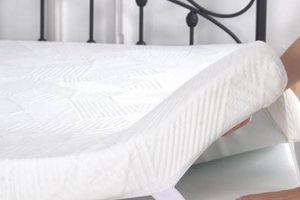
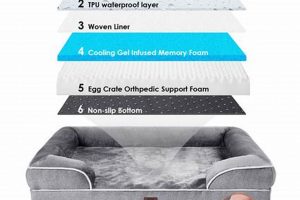
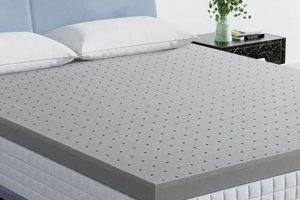
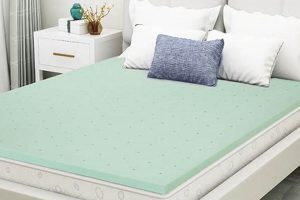
![Top Rated Best Memory Foam Mattress Brands [Year] Organic & Natural Mattress Buyer’s Guide: Non-Toxic Sleep Solutions Top Rated Best Memory Foam Mattress Brands [Year] | Organic & Natural Mattress Buyer’s Guide: Non-Toxic Sleep Solutions](https://mattressworldpa.com/wp-content/uploads/2025/07/th-4022-300x200.jpg)
